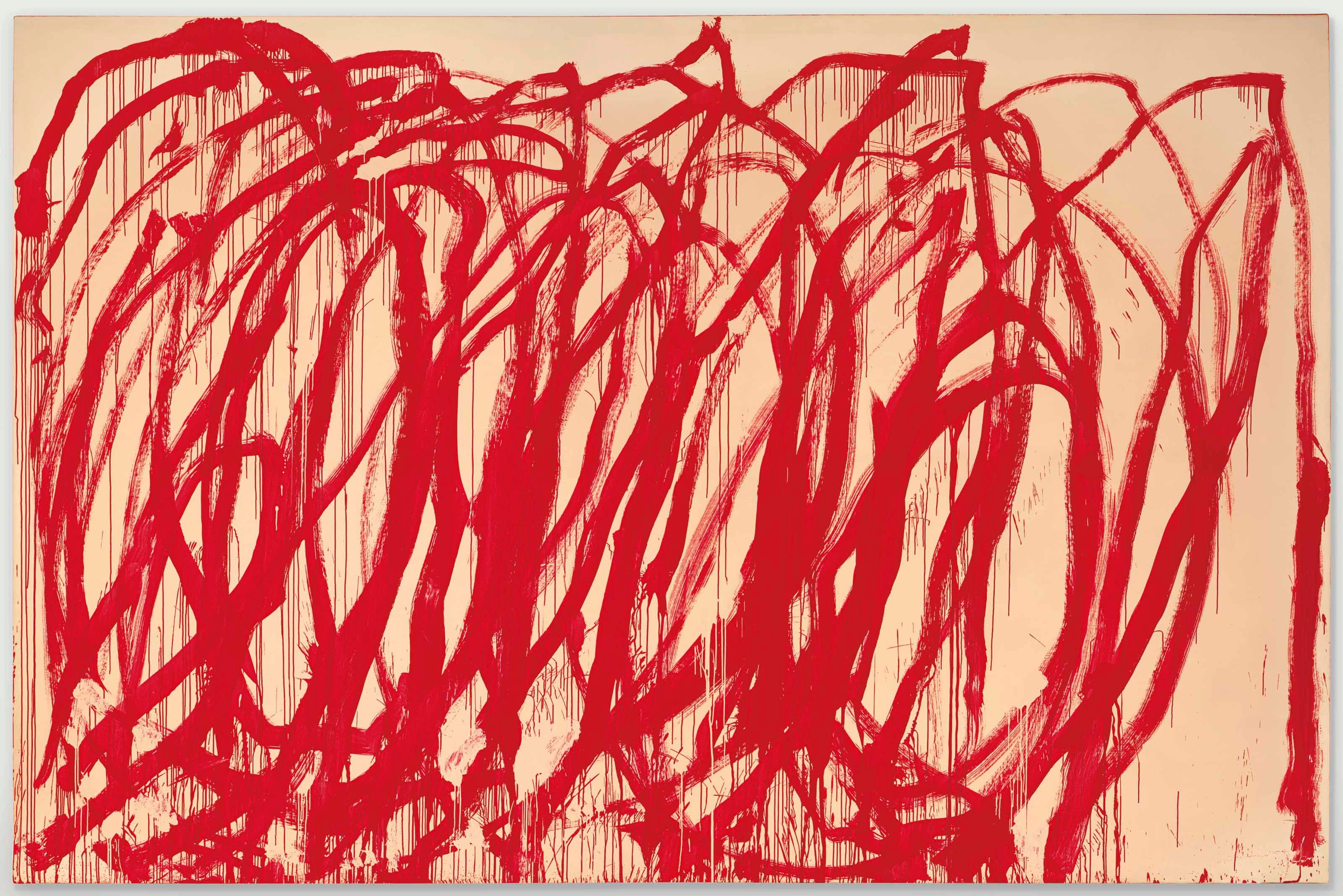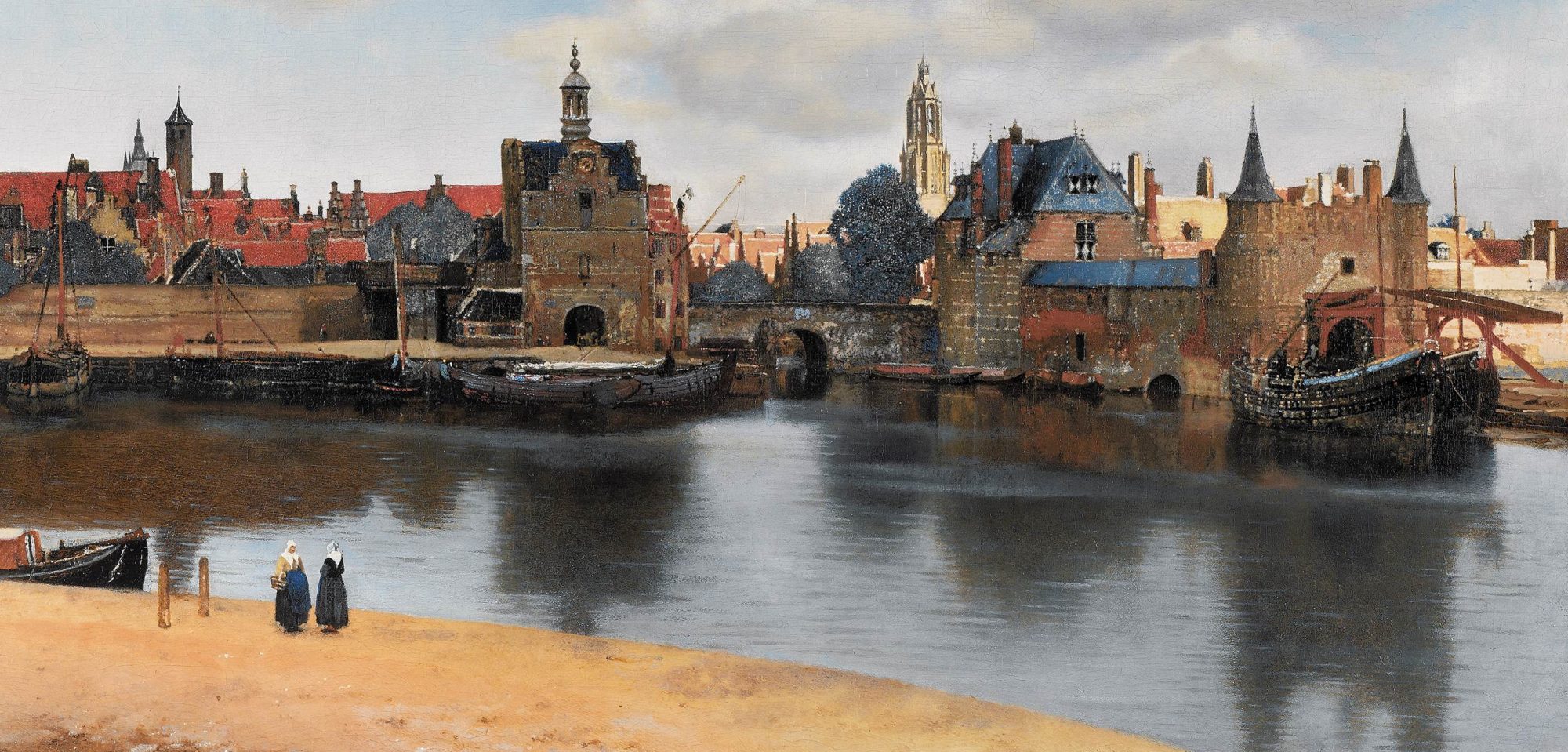“To my mind, one does not put oneself in place of the past; one only adds a new link.”
Cy Twombly, quoted by Gagosian
“an elemental Dionysian force of madness rising, like a ‘fire that rises from the depths of the sea'”
Malcolm Bull, “Fire in the Water,” in Cy Twombly Bacchus Psilax Mainonmenos, exh. cat., New York, 2005, p. 55), quoted in Lot Essay, Cy Twombly (1928-2011), “Untitled” (acrylic on canvas, painted in 2005), Christie’s, Post-War & Contemporary Art Evening Sale, New York, 15 November 2017, Lot 15 B

Over ten feet high and sixteen feet in length, “Untitled” is the largest example from a group of giant-scaled paintings that Twombly created beginning in 2003 at age 75.
Twombly makes use of spirals of linear loops, culminating fifty years of regularly invoking scrawls, whirls, and writing/drawing.
“In his catalogue essay, “Fire in the Water” that accompanied the first exhibition of Twombly’s Bacchus series in 2005, Malcolm Bull argued that the abiding theme of these paintings was that of an elemental Dionysian force of madness rising, like a “fire that rises from the depths of the sea” (M. Bull, “Fire in the Water,” in Cy Twombly Bacchus Psilax Mainonmenos, exh. cat., New York, 2005, p. 55).’ – Lot Essay
Like Dionysian forces of madness, we are all experiencing the dislocation caused by the current COVID-19 pandemic.
Individuals, families, supply chains, industries, markets, businesses, nations – all are affected.
This pandemic, however terrible, unexpected, and unprepared for, may in part be an outcome of behaviors that we have, however unwittingly, engaged in over decades.
We are all – individuals, peoples, cultures, animals, plants, functional objects and works of art, buildings, systems of transportation, agriculture, and education, etc. etc. etc. – inextricably embedded in nature. We are part and parcel of and subject to the forces of physics. Part and parcel of and subject to the elements and interactions of chemistry.
As living, breathing creatures, moreover, and complex systems of systems. we are part and parcel of and subject to the complex forces of biology. We are calibrated precisely, over long periods of time, to our biosphere.
If and should we take our biosphere for granted, fundamentally alter the composition of our atmosphere, and tamper with our climate, the unexpected can occur. Mayhem may let loose,
And so it has.
Yet, in the arts we are global. We reach across time, across space, across borders, across cultures, across nations. We represent mind and passion, interests and preferences. We come from an abundance of backgrounds and industries.
We may lead, each in our own place, taking steps to realize our ambitions anew.
Together we will have impact.
While we work in our many spheres of activity, what steps, however simple, might we take to realize our objectives while mitigating risks of future such dislocations?
If we want “to do something to prevent disease emergence, first of all we need to seriously reconsider how we do business with the biosphere.”
“Q & A: A Harvard Expert on Environment and Health Discusses Possible Ties Between COVID and Climate,”
“We need to hear what nature is trying to tell us, which is clear: let’s be smarter about how we do business with the biosphere and stop disrupting the climate we depend on.”
Conversation on COVID-19 with Dr. Aaron Bernstein, Director of Harvard C-CHANGE”
Two recently published articles are insightful. In them, Dr. Aaron Bernstein, MD, MPH, Director of The Center for Climate, Health, and the Global Environment at Harvard’s T.H. Chan School of Public Health (Harvard C-CHANGE) offers guidance.
Please take a few minutes to read them in full:
Neela Banerjee, “Q & A: A Harvard Expert on Environment and Health Discusses Possible Ties Between COVID and Climate,” Inside Climate News, 12 March 2020
“A Conversation on COVID-19 with Dr. Aaron Bernstein, Director of Harvard C-CHANGE, ” Harvard C-CHANGE
Excerpts follow, giving us some idea of what we probably already know but don’t always think about or consider in the decisions we make on a daily basis:
“The bottom line here is that if you wanted to prevent the spread of pathogens, the emergence of pathogens, … you wouldn’t transform the climate.”
“Q & A: A Harvard Expert on Environment and Health Discusses Possible Ties Between COVID and Climate,”
“The separation of health and environmental policy is a dangerous delusion. Our health entirely depends on the climate and the other organisms we share the planet with.”
“A Conversation on COVID-19 with Dr. Aaron Bernstein, Director of Harvard C-CHANGE”
Simply put, “The likelihood is high that this [a next pandemic] will happen. This has happened through human history but the data we have shows that the pace is accelerating. That’s not terribly surprising. We’re living in highly dense urban places. Air travel is much more prevalent than it used to be. And climate is a part of what is fundamentally reshaping our relationship with the natural world.”
“Q & A: A Harvard Expert on Environment and Health Discusses Possible Ties BetweenCOVID and Climate”
“You look at climate change, we have transformed the nature of the Earth. We have fundamentally changed the composition of the atmosphere, and, as such, we shouldn’t be surprised that that affects our health.”
“If you look at the emerging infectious diseases that have moved into people from animals or other sources over the last several decades,the vast majority of those are coming from animals. And the majority of those are coming from wild animals. We have transformed life onEarth. We are having a massive effect on how the relationships between all life on Earth operate and also with ourselves. We shouldn’t be surprised that these emerging diseases pop up.
“The principle is that we’re really changing how we relate to other species on Earth and that matters to our risk for infections.”
“Q & A: A Harvard Expert on Environment and Health Discusses Possible Ties Between COVID and Climate”
“Historically, we have grown as a species in partnership with the plants and animals we live with. So, when we change the rules of the game by drastically changing the climate and life on earth, we have to expect that it will affect our health.”
“A Conversation on COVID-19 with Dr. Aaron Bernstein, Director of Harvard C-CHANGE”
How might we in our private and business capacities be smarter about how we do business with the biosphere and stop disrupting the climate we depend on?
First, think.
All industries, markets, and economies, including the arts, the art market, and the art economy, are interconnected and all are viable only within our shared biosphere.
“Art” is not self-existent. Art as a phenomenon, culture as a phenomenon, works of art, cultures, collections of works of art, collectors, and all parties to art are inextricably embedded in and dependent on nature.
Take time and steps to learn about and understand the biosphere. Take steps to reconsider how we, in every sphere of work and activity, do business with the biosphere.
We have an opportunity to consider ways to optimize connections, culture, art, the business of art, and the biosphere jointly.
Some simple steps that can be taken:
Minimize travel
Whether curator, museum director, staff, or trustee, collector, dealer, gallerist, advisor, interested party – vet travel requirements.
Minimize travel powered by combustion of hydrocarbons.
“We need to drastically decrease our greenhouse gas emissions from fossil fuels like coal, oil and natural gas.”
“A Conversation on COVID-19 with Dr. Aaron Bernstein, Director of Harvard C-CHANGE”
It goes without saying that travel by foot or by bike is encouraged. Travel by electric-powered cars, buses, and trains – especially insofar as the electricity is generated from renewable, non-hydrocarbon sources – is also encouraged.
Amsterdam-based art dealer Jan Six XI, for instance, bikes to and from work, and across town to consult with experts. (Russell Shorto, “Rembrandt in the Blood: AnObsessive Aristocrat, Rediscovered,” The New York Times Magazine, 27 February 2019)
Work with local partners
We are all somewhere. We do not need to be everywhere.
If you need to do work or close a transaction somewhere else, research, identify, vet, and work with local partners.
Optimize resources and connections made available online
Information, images, and opportunities to meet and discuss face-to-face, even in groups, abound online. As we are now seeing in abundance, education and research can be conducted online. Relationships developed through written and verbal communications optimized online, by mail (even mail that goes through the post office), and by telephone.
As much activity is migrating online, vet also your online service partners and their delivery options.
This website, for instance, is hosted by AISO.net. AISO.net is powered 100% by solar energy generated on site. The company does not make use of carbon credits. Members of staff are knowledgeable, of course, very personable, and extraordinarily helpful. They are great to work with.
Reduce carbon dioxide and greenhouse gas emissions from ongoing operations of physical plants
Galleries,museums, homes, businesses, offices, schools and universities, hotels,hospitals – all house works and collections of art.
Real-life steps can be taken to reduce use of hydrocarbon-based energy sources and achieve net-zero energy.
Expert and experienced stakeholders including architects, engineers, designers, builders, energy consultants, and sources of finance are able and ready to assist.
Information about service providers will follow.
Amsterdam’s Van Gogh Museum can serve as a model. The Van Gogh Museum operates 100% on renewable (wind)energy. (See Van Gogh Museum, sustainability, and accompanying infographic.)
Change habits of mind and behavior
Allow time for foot and bike travel. Schedule meetings and work requirements accordingly.
Enjoy the great outdoors en route to work, home, meetings, and shopping.
Enjoy your locality
See:
Cy Twombly (1928 – 2011), “Untitled” (acrylic on canvas, painted in 2005), Christie’s, Post-War & Contemporary Art Evening Sale, New York, 15 November 2017, Lot 15 B
“Coronavirus, climate change, and the environment, A Conversation on COVID-19 with Dr. Aaron Bernstein, Director of Harvard C-CHANGE”, Harvard C-Change, 20 March 2020
Aaron Bernstein, MD, MPH, C-Change,Center for Climate, Health, and the Global Environment, Harvard T.H. Chan School of Public Health
Neela Banerjee, “Q&A:A Harvard Expert on Environment and Health Discusses Possible TiesBetween COVID and Climate,” Inside Climate News, 12 March 2020
Russell Shorto, “Rembrandt in the Blood: An Obsessive Aristocrat,Rediscovered,” The New York Times Magazine, 27 February 2019
